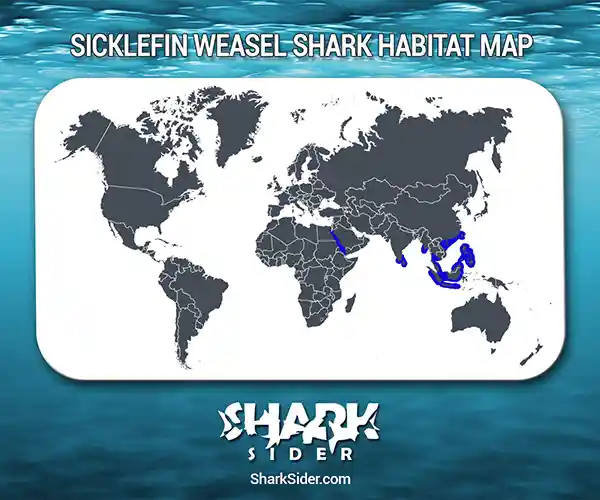The sicklefin weasel shark is a ground shark swimming in the Indian Ocean. It gets its name from its fins which are all primarily falcate.
Sicklefin Weasel Shark Scientific Classification |
|
| Kingdom | Animalia |
| Phylum | Chordata |
| Class | Chondrichthyes |
| Order | Carcharhiniformes |
| Family | Hemigaleidae |
| Genus | Hemigaleus |
| Scientific Name | H. microstoma |
Description
On average, this shark is 3.6 ft long. It has a long rounded snout, large oval eyes with protective third eyelids, and nostrils covered with skin flaps. The shark’s mouth forms a short and wide arch, inside which are 25–34 broad upper and 37–43 narrow and erect lower tooth rows.
This shark’s fins are sickle-shaped, with the pectoral fins pointed, the first dorsal fin more significant than the second, and the anal fin tinier than the second dorsal fin.
Dorsally these sharks are light grey or bronze, while the ventral side is paler. There are white spots on the sides and white edges on the dorsal fins.
Where do they live
Map Of The Sicklefin Weasel Shark’s Habitat

This shark is found throughout Southeast Asia, with sightings in Borneo, Java, southern China and India, Sri Lanka, and Taiwan. They inhabit continental and insular shelves from coastal waters to depths of 560 ft and usually dwell close to the sea floor.
Behavior
Hunting
Sicklefin weasel sharks feed mainly on cephalopods but sometimes consume crustaceans and echinoderms. Their weak jaws and small teeth are built for holding and tearing into soft-bodied prey.
Reproductive
These sharks are viviparous, giving live birth to a litter of 2-4 pups twice a year. At birth, the newborn sharks are around 18 inches long.
Sexual maturity is observed in males when they are 29–30 inches long and in females when they are 30–31 inches long.
Interactions with humans
This shark is harmless to humans. It is often captured for human consumption, with the fins used in shark fin soup and the rest ground into fishmeal. While its reproductive rate remains high, the IUCN classifies it as “Vulnerable” or “VU” due to its rarity.
